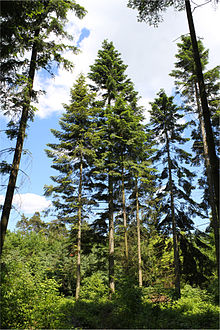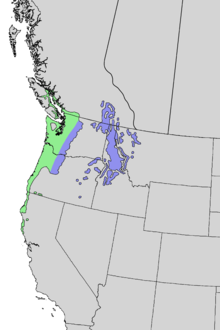Abies grandis
| Abies grandis Grand fir | |
|---|---|

| |
| Scientific classification | |
| Kingdom: | Plantae |
| Clade: | Tracheophytes |
| Clade: | Gymnospermae |
| Division: | Pinophyta |
| Class: | Pinopsida |
| Order: | Pinales |
| Family: | Pinaceae |
| Genus: | Abies |
| Species: | A. grandis
|
| Binomial name | |
| Abies grandis | |

| |
| Natural range of Abies grandis
green - A. grandis ssp. grandis
blue - A. grandis ssp. idahoensis
| |
Abies grandis (grand fir, giant fir, lowland white fir, great silver fir, western white fir, Vancouver fir, or Oregon fir) is a fir native to northwestern North America, occurring at altitudes of sea level to 1,700 metres (5,600 ft). It is a major constituent of the Grand Fir/Douglas Fir Ecoregion of the Cascade Range.
The tree typically grows to 40–70 m (130–230 ft) in height, and may be the tallest Abies species in the world. There are two varieties, the taller coast grand fir, found west of the Cascade Mountains, and the shorter interior grand fir, found east of the Cascades. It was first described in 1831 by David Douglas.[2]
It is closely related to
Description
Abies grandis is a large

The green-to-reddish cones are 6–12 cm (2+1⁄4–4+3⁄4 in) long[3] and 3.5–4.5 cm (1+1⁄2–1+3⁄4 in) broad, with about 100–150 scales; the scale bracts are short, and hidden in the closed cone. The winged seeds are released when the cones disintegrate at maturity about 6 months after pollination.[1]
Varieties
There are two varieties, probably better treated at subspecies rank though not yet formally published as such:
- Abies grandis var. grandis. Coast grand fir. Coastal lowland forests, at sea level to 900 m altitude, from Vancouver Island and coastal British Columbia, south to Sonoma County, California. A large, very fast-growing tree to 70 m tall. Foliage strongly flattened on all shoots. Cones slightly narrower (mostly less than 4 cm broad), with thinner, fairly flexible scales. Tolerates winter temperatures down to about -25° to -30 °C; growth on good sites may exceed 1.5 m per year when young.[1]
- Abies grandis var. idahoensis. Interior grand fir. Interior forests, at (600–) 900–1800 m altitude, on the east slope of the Cascades in Washington and in the Rocky Mountains from southeast British Columbia south to central Idaho, northeast Oregon and western Montana. A smaller, slow-growing tree to 40–45 m tall. Foliage not strongly flattened on all shoots, the leaves often raised above the shoot, particularly on upper crown shoots. Cones slightly stouter (mostly over 4 cm broad), with thicker, slightly woody scales. Tolerates winter temperatures down to about -40 °C; growth on good sites not exceeding 0.6 m per year even when young.[1]
Grand fir is very closely related to
Taxonomy
The species was first described by Scottish botanical explorer David Douglas, who in 1830 brought its seeds back to Britain;[3] in 1831 he described specimens he had collected along the Columbia River in the Pacific Northwest.[2]
Distribution and habitat
The coastal variety of grand fir grows in temperate rainforest environments along the Pacific coast from southwest
Ecology
Due to
Specimens have historically been able to live up to nearly 300 years, but in modern stressed conditions, 100 years is more typical.
Pileated woodpeckers search grand and white firs for insects and places to nest. Rotten cores open shelters for various animals, including black bears.[3]
Uses
The boughs create a rain shelter for humans.[3]
Native Americans used both grand fir and white fir, powdering the bark or pitch to treat tuberculosis or skin ailments; The Okanagan-Colville tribe used the species as a strengthening drug to nullify the feeling of weakness.[8]
The foliage has an attractive
Timber

The lumber is non-resinous and fine textured.[2] In the North American logging industry, the grand fir is often referred to as "hem fir", with hem fir being a number of species with interchangeable types of wood (specifically the
Lumber from the grand fir is considered a
As a hem fir, the trunk of the grand fir is considered slightly below the "Douglas fir-
Notable specimens
In February 2022, a coast grand fir growing south of Bergen was found to be Norway's tallest tree with height of 53.7 m (176 ft).[10]
References
- ^ . Retrieved 12 November 2021.
- ^ a b c "Brochure: White Fir Facts" (PDF). SPI. Archived from the original (PDF) on 2011-11-05. Retrieved 2012-01-12.
- ^ OCLC 1141235469.
- ISSN 1385-0237.
- ISSN 0305-1978.
- ^ Kauffmann, Michael (2012). Conifer Country. Backcountry Press. pp. 35–38.
- ISBN 0-295-97119-3.
- OCLC 8519706.
- ^ a b "Hem-Fir species group". Western Woods Products Association. March 1997. Archived from the original on 2012-07-12. Retrieved 2012-07-10.
- ^ "The thickest, tallest, and oldest trees in Norway".



